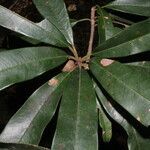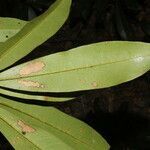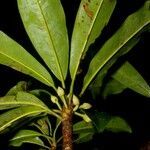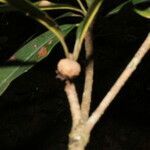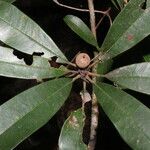Tree to 40 m. Leaves with petioles 1-3.5 cm long; blades 8-24(-29) cm long, 3-7(-10) cm broad, oblanceolate or narrowly obovate to elliptic or elliptic-oblong, obtuse or rounded to acute or acuminate, paler and more yellowish beneath, ap-pressed-sericeous-strigulose below when young but eventually glabrate. Flowers yel-lowish-or grenish-white, 2-5 per fascicle; pedicels strigulose, 0.5-3 cm long; sepals 5-9 mm long, ovate to ovate-lanceolate or ovate-oblong, the inner and outer sericous-tomentulose; corolla 5.5-9 mm long, the tube I/4-1/2 the total length, the lobes ovate, often erose or erose-dentate at the apex, lacking dorsal appendages; sta- minodes 2.5-4.5 mm long, distally erose-laciniate, often shallowly bifid; stamens equalling the staminodes; ovary minutely sericeous on top, glabrous elsewhere, the style 6-9 mm long, glabrous except at the base. Fruit mealy-roughened, 2-4 cm in diam, subglobose or obovoid, several-seeded; seeds 14-19 mm long, flattened, the basilateral scar barely reaching the middle.
More
A tree. It grows 25-35 m high. It can have short buttresses 0.5 m high. The bark is dark grey and almost black. It is deeply cracked. The young shoots are slightly rough. The leaves are 6-20 cm long by 2-7.3 cm wide. They are usually rounded and sword shaped. There are 15-25 pairs of secondary veins. The leaf stalk is 1-2.5 cm long. Trees shed their leaves for a short period of time where there are seasonal climates. The flowers occur as 2-5 together on branches from the same point. They are rough skinned and pale brown. The flower stalks are 0.6-1.7 cm long. The fruit are 2.5-3.5 cm long by 2.5-4.8 wide. They are rounded and flattened. There are 2-5 seeds. They are 1.5-2.5 cm long. They are flattened.
